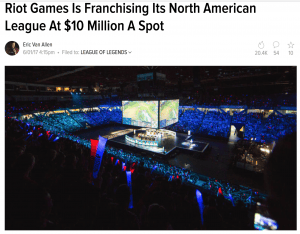Originally posted on our CEO’s Medium page
When we see numbers about the growth of the Esports business, we normally see those numbers separated from the game industry overall. And all too often, we do not consider the underlying power dynamics of the games ecosystem, and how the Esports business is situated within it.
The plain truth of this ecosystem is the hegemonic power of the game content owners, be they publisher or developers.
Esports exists because communities of gamers came together to enjoy watching people play their favorite games. Now we find ourselves on the cusp of graduating from this “community-based activity” to a more formalized and potentially profitable ecosystem.
Esports as a business is about the broadcasting rights of game content, and therefore, the power reverts to the rights-holders, the game publishers.
When we at Genvid approached the esports opportunity, we came to the conclusion that if we built our startup around the publisher rather than withthe publisher — and building around includes the use of publicly available game APIs — we would be building our business on shaky ground. Instead, we build tools for developers, aligning incentives and making them our customers.
It continuously surprises me how many Esports opportunities are being built on top of publisher’s content assuming the publishers will ignore ancillary businesses.
This leads to a catch-22 situation: claims of amassing value in this ecosystem assuming that the parties with the most to gain and most control over the ecosystem will just ignore their activities.

Riot’s announcement last month about a franchising system was widely anticipated
To date, publishers have broadcasting ownership, but either treat esports as a marketing tool (Electronic Arts) or as an ancillary ecosystem (Valve). Only a few publishers have attempted the next stage: consolidation leading toward the transformation of marketing cost center to broadcasting revenue center (Riot, Activision).
But when the latter consolidation happens — publishers decide to take Esports seriously — you get vertical integration of the stack by the publisher (see Overwatch League, Riot’s franchise system), leading to the rusg being pulled under businesses which have sprouted on top of the content.
Hence the catch-22: When businesses in their ecosystem aren’t making money, the publisher will ignore them, but when the ecosystem is growing, the publisher can pull its weight to capture that value. (Or, if the publisher just doesn’t like what’s going on with these ancillary businesses, they can pull the plug with a cease and desist.)
Which is it — is there is a lot of value to be had or not? And if there is so much value, why would the publishers continue to allow others to operate so freely without their involvement?
Startups that treat the content owner as their source of business — companies who thread the needle between the needs of the publishers and their own independence — can survive this catch-22. Startups will need to prove that they provide value that the publishers could not, or would not, be in a position to provide themselves.
I urge investors and startup founders alike to think critically about how their opportunity takes into consideration the game content owners’ catch-22.


